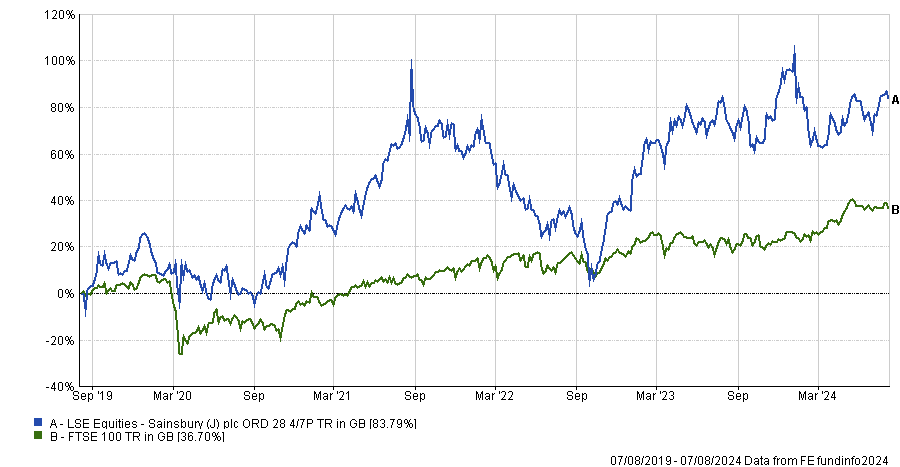Inspiration can come from the least likely and most mundane of places and currently there are ample investment ideas to be found whilst shopping for groceries: from the consumer staples brands gracing the shelves – as well as the portfolios of Guinness Global Equity Income and Evenlode Income – to the supermarkets themselves.
As a case in point, the Gresham House UK Multi Cap Income fund has built a position in Sainsbury’s in the past month.
In a similar vein, Laura Foll, co-manager of Henderson Opportunities Trust, Lowland and Law Debenture, holds Sainsbury’s and Tesco across all her portfolios and has been adding to both in recent months.
The industry backdrop has evolved over the past decade, said Brendan Gulston, director, public equity at Gresham House. Aggressive store rollouts have been curtailed and the price wars of the past have all but ceased. Morrisons and Asda are private equity-owned with high levels of financial leverage, so their ability to engage in aggressive tactics has been restricted, he added.
Foll agreed that “industry dynamics have changed”, although supermarkets remain “fiercely competitive”. “Both Tesco and Sainsbury have brought prices much closer to the discounters, making it an easier choice for consumers to do one big shop,” she said, resulting in market share gains for both supermarkets. Tesco remains the largest in the UK at 27.7% of the market, according to data from Kantar Worldpanel, while Sainsbury's is second with 15.3%.
Tesco and Sainsbury’s have conservatively managed their balance sheets and are “using this balance sheet heft to invest heavily in their store estate and elsewhere”, she explained. “Sainsbury, for example, is guiding to a capex for this year of circa £800m. Part of the thinking behind this substantial investment may be to put some permanent ‘white space’ between them and their more indebted competitors.”
Below, fund managers articulate their investment theses for Sainsbury’s and Tesco.
Sainsbury’s
Gulston said Sainsbury’s’ valuation is attractive at 10x forward earnings before interest and taxes (EBIT), the lowest level at which it has traded in at least four years. Crucially for an income fund, it has a 5% dividend yield and a 60% payout ratio, so the dividend is fully covered. Sainsbury’s also possesses a £6.5bn portfolio of freehold land and buildings, mostly in London and the south of England.
If the stock experiences a modest rerating to 11.5x EBIT, he thinks he could double his investment over a five-year horizon.
Performance of Sainsbury’s over 5yrs vs FTSE 100

Source: FE Analytics
Sainsbury’s has some “compelling self-help levers” to pull, said FE fundinfo Alpha Manager Gulston. Just 15% of stores carry its full food and grocery range, including ‘Taste the Difference’ and private label products. The conversion rate to other products is much higher in stores that stock the full range, so Sainsbury’s has a compelling opportunity to expand the range in its other stores.
The grocer is also implementing cost savings by running its business more holistically. For instance, procurement might choose a cheaper product, delivering an initial saving, but it might take longer to unpack, thus increasing the cost of store labour. Sainsbury’s has started looking at end-to-end costs including how procurement decisions affect store labour and in turn, how store labour impacts restocking and the supply chain. The company has delivered £1bn in savings already in this way and expects to save more, he explained.
Co-located Argos pick-up spots also provide an opportunity for cross-selling to the 50% of UK households who shop there.
Meanwhile, higher online penetration is improving margins. Delivering goods bought online to customers’ homes involves a high fixed cost base so the incremental profit from higher online penetration is significant.
Furthermore, Sainsbury’s has a wealth of first-party data through its Nectar loyalty platform, which it can use to target customers through email campaigns and social media. The supermarket chain aims to generate £100m of incremental profit by 2027 by monetising its first-party data more effectively.
Tesco
Nick Shenton, co-manager of the £4.7bn Artemis Income fund, has held Tesco since January 2017. “The business has faced up to the full force of disruption from discounters and come out stronger and fitter. Tesco has more market share online than offline today, which shows it is a truly multi-channel business,” he said.
“It serves customers, however and wherever they want to shop. If you want to do your big shop once a week at Tesco, you can do that. If you want to get ingredients in less than 30 minutes via its Whoosh service, you can do that too. And everything in between. Tesco has invested in value, quality and service, which means it’s winning with customers and taking market share.”
Management has focused on improving return on capital and cashflow, so “we have been enjoying a 4% dividend yield that grows at 5% a year from share buybacks alone”.
Like Gulston, Shenton thinks that Tesco’s scale, data and insights are a huge competitive advantage. It has used artificial intelligence for years and will continue doing so to greater effect, he said. “But the key point is that you need the data – Tesco has it and so can be an even smarter business.”





